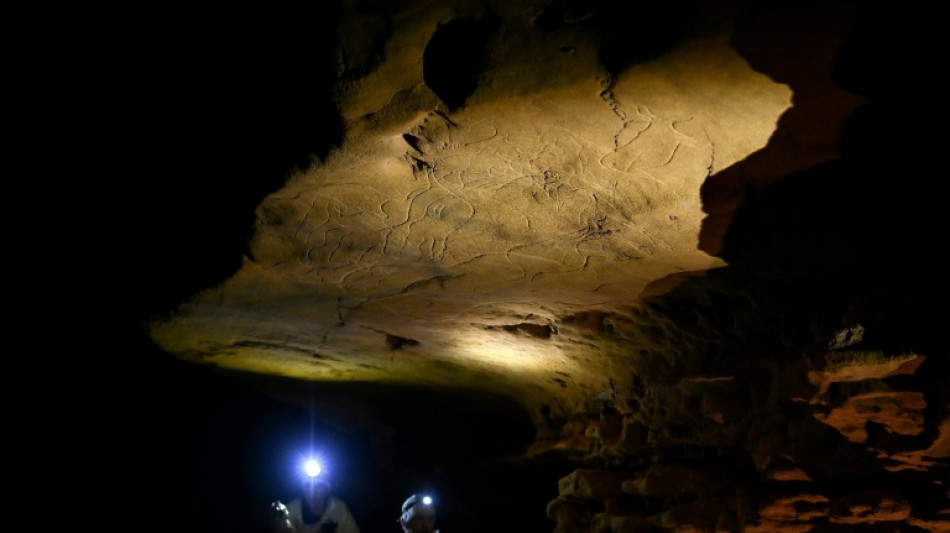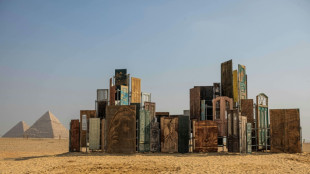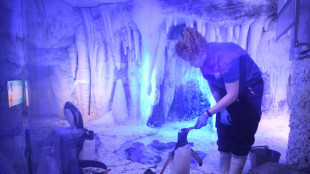
-
 Iraqi voters turn out in numbers as region watches on
Iraqi voters turn out in numbers as region watches on
-
Pakistan upstage Sri Lanka in first ODI as Agha and Rauf shine

-
 Macron warns any planned West Bank annexation a 'red line'
Macron warns any planned West Bank annexation a 'red line'
-
BBC must fight, says outgoing chief as Trump threatens to sue

-
 UN aid chief hails talks with Sudan army leader
UN aid chief hails talks with Sudan army leader
-
Mellon Blue diamond sells for $25.6 million

-
 Google unveils $6.4 bn investment in Germany
Google unveils $6.4 bn investment in Germany
-
US aircraft carrier in Latin America fuels Venezuelan fears of attack

-
 For many Syrians, Sharaa's US visit marks new beginning
For many Syrians, Sharaa's US visit marks new beginning
-
Monumental art displayed in shade of Egypt's pyramids

-
 Stocks mixed as tech titans struggle
Stocks mixed as tech titans struggle
-
California governor Newsom slams Trump at COP30

-
 Alcaraz fights back to beat Fritz at ATP Finals
Alcaraz fights back to beat Fritz at ATP Finals
-
Russia offers US nuclear talks in bid to ease tensions

-
 Turkey seeks more than 2,000 years behind bars for Erdogan rival
Turkey seeks more than 2,000 years behind bars for Erdogan rival
-
UK court jails Chinese bitcoin fraudster for over 11 years

-
 Fanfare as Guinea launches enormous Simandou iron ore mine
Fanfare as Guinea launches enormous Simandou iron ore mine
-
Iraqis vote in general election at crucial regional moment

-
 Shock follows carnage after suicide bombing in Islamabad
Shock follows carnage after suicide bombing in Islamabad
-
Ford returns to pull England strings against All Blacks

-
 Stocks mixed as end to US shutdown appears closer
Stocks mixed as end to US shutdown appears closer
-
BBC must 'fight' for its journalism, outgoing chief says amid Trump lawsuit threat

-
 Atalanta turn to Palladino after Juric sacking
Atalanta turn to Palladino after Juric sacking
-
'Sayyid says': Influential Shiite cleric's supporters boycott Iraq vote

-
 'It's un-British': lawmakers raise concerns about aquarium penguins
'It's un-British': lawmakers raise concerns about aquarium penguins
-
Prosecutor files 142 charges against Istanbul mayor, a top Erdogan critic

-
 Agha hundred lifts Pakistan to 299-5 in 1st Sri Lanka ODI
Agha hundred lifts Pakistan to 299-5 in 1st Sri Lanka ODI
-
German court rules against OpenAI in copyright case

-
 Calls for 'mano dura' as crime-rattled Chile votes for president
Calls for 'mano dura' as crime-rattled Chile votes for president
-
Pakistani Taliban claim deadly suicide attack in Islamabad

-
 BBC grapples with response to Trump legal threat
BBC grapples with response to Trump legal threat
-
Cristiano Ronaldo says 2026 World Cup 'definitely' his last

-
 Trump says 'we've had a lot of problems' with France
Trump says 'we've had a lot of problems' with France
-
Stocks mostly rise as end to US shutdown appears closer

-
 'Splinternets' threat to be avoided, says web address controller
'Splinternets' threat to be avoided, says web address controller
-
Yamal released from World Cup qualifiers by 'upset' Spanish federation

-
 China's 'Singles Day' shopping fest loses its shine for weary consumers
China's 'Singles Day' shopping fest loses its shine for weary consumers
-
Suicide bombing in Islamabad kills 12, wounds 27

-
 Philippines digs out from Typhoon Fung-wong as death toll climbs
Philippines digs out from Typhoon Fung-wong as death toll climbs
-
Iraqis vote in general election at a crucial regional moment

-
 Asian stocks wobble as US shutdown rally loses steam
Asian stocks wobble as US shutdown rally loses steam
-
UK unemployment jumps to 5% before key govt budget

-
 Japanese 'Ran' actor Tatsuya Nakadai dies at 92
Japanese 'Ran' actor Tatsuya Nakadai dies at 92
-
AI stock boom delivers bumper quarter for Japan's SoftBank

-
 Asian stocks struggle as US shutdown rally loses steam
Asian stocks struggle as US shutdown rally loses steam
-
India probes deadly Delhi blast, vows those responsible will face justice

-
 Pistons win streak hits seven on night of NBA thrillers
Pistons win streak hits seven on night of NBA thrillers
-
US state leaders take stage at UN climate summit -- without Trump

-
 Burger King to enter China joint venture, plans to double stores
Burger King to enter China joint venture, plans to double stores
-
Iraqis vote in general election in rare moment of calm


Rarely seen cave art holds prehistoric secrets in France
Deep inside a labyrinthine cave in southwestern France, ancient humans who lived around 30,000 years ago carved horses, mammoths and rhinoceros into the walls, a fabulous prehistoric menagerie that has rarely been seen -- until now.
Discovered in 2000 by an amateur cave explorer, the Grotte de Cussac in the Dordogne department holds ancient human remains, traces of long-extinct bears and stunning, fragile artworks its custodians go to great lengths to preserve.
Typically, the French authorities restrict access to the cave to researchers, who are only allowed to enter it four weeks per year.
But a team of AFP journalists was recently allowed to visit the cave for the first time, accompanied by scientists working to unravel its mysteries.
After unlocking the metal grate that blocks the entrance, the group put on white protective overclothes, head coverings and gloves, then disinfected the soles of their boots.
Authorities are anxious to avoid a repeat of the damage done to France's famed Lascaux caves by microorganisms brought in by visitors.
The Lascaux caves -- which are also located in Dordogne, though their artworks are estimated to be thousands of years younger than the Cussac carvings -- were closed to the public in 1963 to save their precious frescoes.
The Cussac cave is accessed by a narrow passage through boulders that have closed off its inner chambers for thousands of years.
Lighting the way with headlamps, visitors cross vast chambers of stalactites and stalagmites, following the same narrow path as Marc Delluc, the late amateur speleologist who discovered the cave in September 2000.
Delluc, who died in 2017, noticed a draft blowing from within the rocks, picked his way through the limestone and uncovered a path of around 100 metres (yards) leading to the engravings.
He described the "rush of adrenaline" he felt when he saw the curved figures and silhouettes carved into the rock overhead.
"I realised the privilege I'd been granted, to enter a place that had been consecrated since the dawn of time," he said.
- 'Sanctuary' -
The 1.6-kilometre (mile-long) cave has more than 1,000 carved figures, both animals and stylised feminine forms.
Scientists have dated them to between 26,000 and 35,000 years ago, the time of the ancient Gravettian culture in Europe.
"The Grotte de Cussac is exceptional for its well-preserved state. It was probably closed off very soon after it was occupied, which protected the soil and vestiges inside," said Emeline Deneuve, chief heritage conservationist for the Nouvelle-Aquitaine region's cultural affairs department.
Claw marks and signs of burrowing show it was also used by cave bears, prehistoric relatives of the brown bear.
Inside their hibernation chambers, researchers have found the remains of six human bodies, dating to the same period as the engravings.
It is the only known example of a cave used by prehistoric humans for both burials and artworks, said the site's lead archaeologist, Jacques Jaubert.
The site was a "sanctuary", not a dwelling, he said. "The group lived outside, in the open or in shelters under the rocks."
- 'Fragments of mythology' -
Jaubert thinks the cave may have been used for initiation ceremonies, "a rite of passage for adolescents to join the adult world" -- a practice often observed in primitive hunter-gatherer groups.
It would also have been seen "as a place of passage between the world of the living and the world of the dead", he said.
The carvings, which he calls "fragments of mythology", were made with flint, wood and bone.
They depict bison, ibex, geese and other animals, as well as women, often with giant heads and tiny feet.
"After testing the wall of the cave, leaving traces with his fingers, the artist carved the first animal figures, which were followed by others superimposed over them," said researcher Valerie Feruglio, who uses 3D imaging to study the artworks, seeking to decipher their stories.
- Safeguarding history -
The cave has still not been fully explored.
But authorities are extremely cautious in protecting the site, which was named a historic monument in 2002.
"We are the guardians responsible for preserving and documenting the site," said Deneuve, the conservation chief.
"We support the research carried out there, as long as it is in line with conservation and heritage requirements. Documenting the cave and digitising it in 3D is also part of our goal to bring it to the public."
In October, the Dordogne department opened a free exhibit on the cave in the town of Buisson-de-Cadouin, with reproductions of its artworks.
But authorities say there are no plans to open the cave to the public.
P.Silva--AMWN


